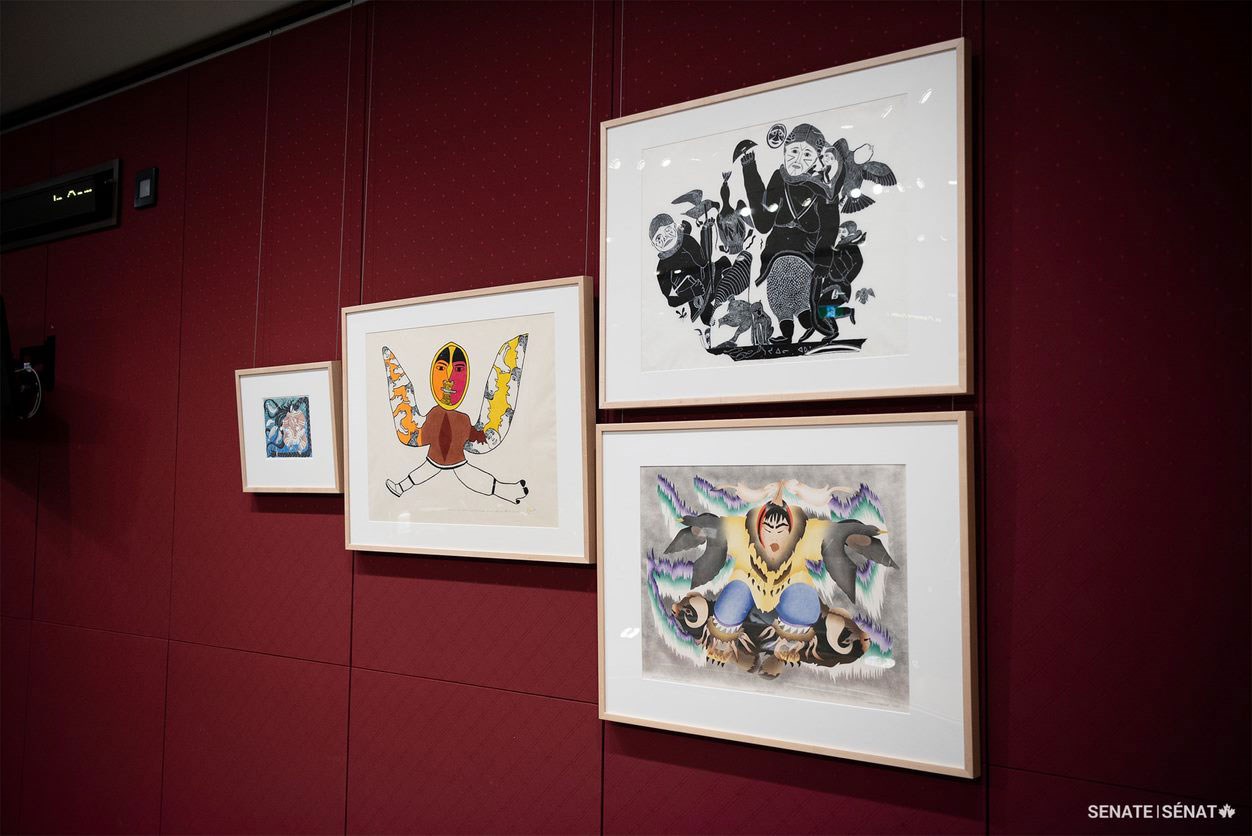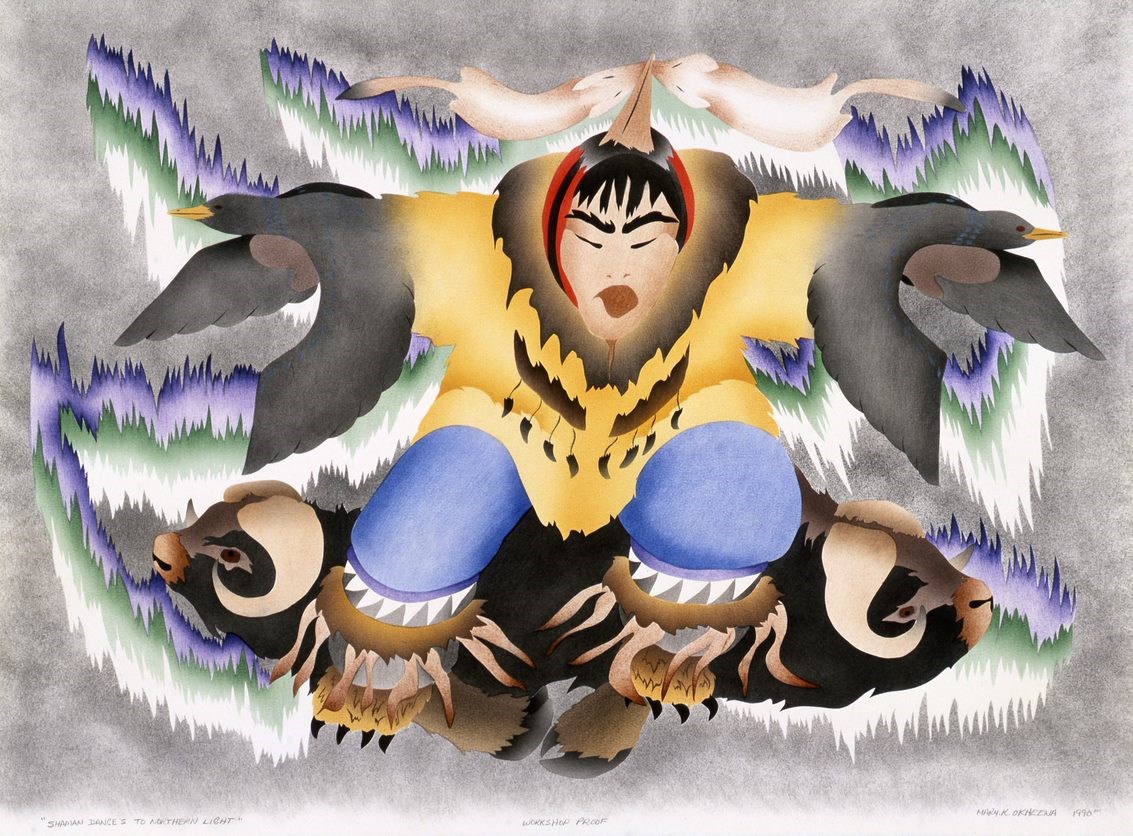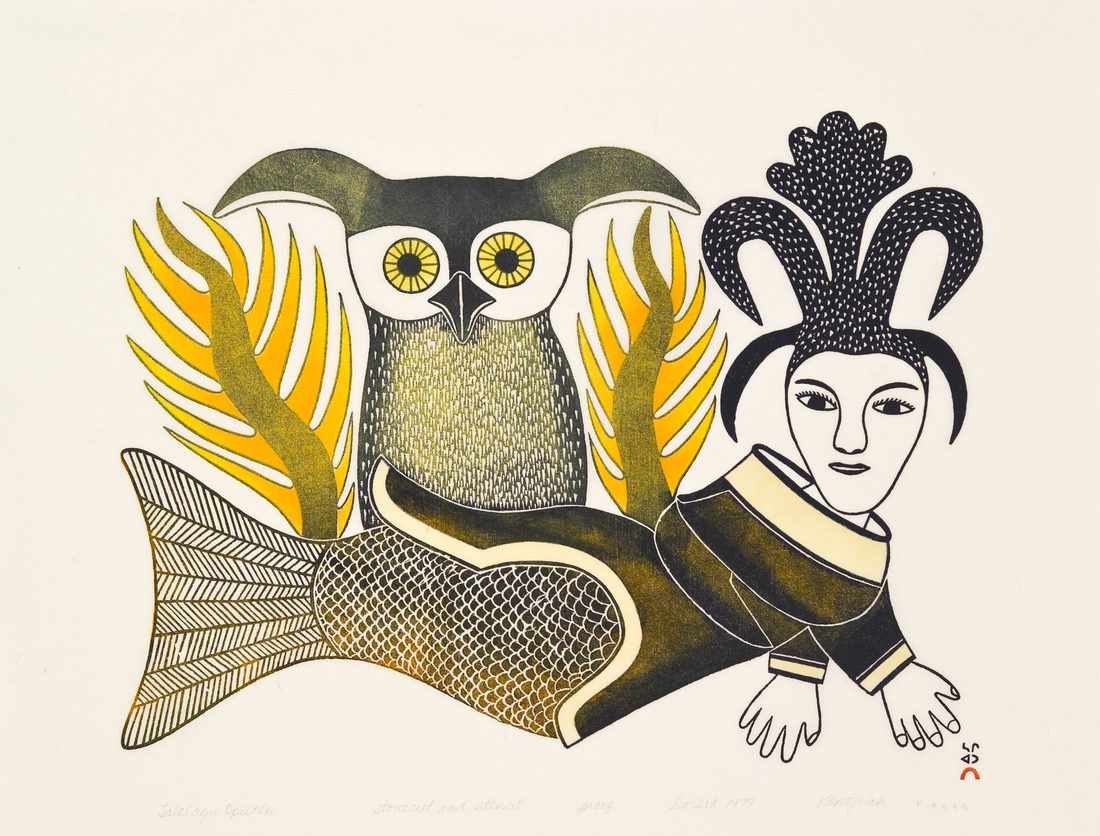Art installation brings Northern voices to the Senate of Canada Building

A collection of prints by renowned Inuit artists will call the Senate of Canada Building home for the next year as part of a new program to showcase Canadian galleries and museums.
Works depicting various aspects of Northern life — from hunting and nature to family life and spirituality — are now the backdrop for senators’ work in committee room B-30.
“We have a big responsibility to make sure we are hearing Canadian voices. The visual arts, dance and music are international languages. These artworks are important voices,” said Senator Patricia Bovey, who is Chair of the Senate’s Artwork and Heritage Advisory Working Group. Senators Josée Forest-Niesing and Vernon White are also members of the working group.
The installation is the first for Museums at the Senate, a program that will bring diverse artwork from museums and galleries across the country to the Senate of Canada Building. This collection of prints is from the Winnipeg Art Gallery-Qaumajuq, which holds the world’s largest public collection of contemporary Inuit art. Qaumajuq is also the temporary home to the Government of Nunavut Fine Art Collection, which is currently being stewarded by the Winnipeg Art Gallery.
“I want Canadians to be really proud of the work that our galleries and museums from coast to coast to coast hold in the public trust for all,” said Senator Bovey. “They hold our history: our natural history, our human history, our scientific history, our cultural history.”
The gallery’s curator of Inuit art Darlene Coward Wight hopes the installation will increase Canadians’ knowledge of Inuit and their culture.
“Works from past and present Inuit artists will hopefully open viewers up to the stories of Inuit,” said Ms. Coward Wight. “I can only hope that this will contribute to tolerance and empathy in our very complex world.”
Introduced to the North in the 1950s, printmaking first took root in the community of Kinngait (Cape Dorset), Nunavut. It became an art form synonymous with Inuit artists, who were often recognized on the international stage.

Select works by Inuit artists are featured on the wall of committee room B-30 in the Senate of Canada Building.

Select works by Inuit artists are featured on the wall of committee room B-30 in the Senate of Canada Building.

Senator Bovey watches as works from the Winnipeg Art Gallery-Qaumajuq are installed in the Senate of Canada Building’s committee room B-30.
Kenojuak Ashevak and Pitaloosie Saila, both featured in the Senate’s exhibit, were among the printmakers of Kinngait. Over the decades, the art form expanded across the North to communities like Puvirnituq, Ulukhaktok (Holman), Baker Lake and Pangnirtung ― where Andrew Qappik, who designed the Nunavut flag, became well known. Each major printmaking community is represented in the collection on display at the Senate of Canada Building.
Printmaking allowed Inuit to share their culture with people in the South, Ms. Coward Wight said.
“Prints are an excellent medium for artists to express themselves and tell their stories to other people because you can often be more detailed than you can in carvings,” she said.
Senator Bovey said the spirit of the installation aligns with the work done by the Senate Special Committee on the Arctic.
“We are doing what we set out to do as the Special Committee on the Arctic: to bring North and South together,” she said. “With this loan, you’ll see those of us who live in the South will get poignant insights into the North and its realities through these artists’ works.”

Mary K. Okheena. Shaman Dances to Northern Lights, 1991. Stencil on paper. Collection of the Winnipeg Art Gallery. Gift of Holman Eskimo Co-operative. (Photo Credit: Ernest Mayer, courtesy of the Winnipeg Art Gallery)

Pitaloosie Saila. Arctic Madonna, 1980. Stonecut, stencil on paper. Collection of the Winnipeg Art Gallery. Gift of Indian and Northern Affairs Canada. (Photo Credit: Leif Norman, courtesy of the Winnipeg Art Gallery)

Simon Tookoome. The World of Men and the World of Animals Come Together in the Shaman, 1973. Stonecut and stencil on paper. Government of Nunavut Fine Art Collection. On long-term loan to the Winnipeg Art Gallery. (Photo Credit: Serge Gumenyuk, courtesy of the Winnipeg Art Gallery)

Kenojuak Ashevak. Talelayu Opiitlu (Talelayu with Owl), 1979. Stonecut, stencil on paper. Collection of the Winnipeg Art Gallery. Gift of Indian and Northern Affairs Canada. (Photo Credit: Ernest Mayer, courtesy of the Winnipeg Art Gallery)

Syollie Amituk. Family Hunting, 1963. Stonecut on paper. Collection of the Winnipeg Art Gallery. The Swinton Collection. (Photo Credit: Ernest Mayer, courtesy of the Winnipeg Art Gallery)

Andrew Qappik. Pause, 2002. stencil on paper. Collection of the Winnipeg Art Gallery. Given by the Council for Canadian American Relations through the generosity of H.G. Jones. (Photo Credit: Leif Norman, courtesy of the Winnipeg Art Gallery).
Note to readers: The Honourable Patricia Bovey retired from the Senate of Canada in May 2023. Learn more about her work in Parliament.
Related articles
Tags
Committee news
Art installation brings Northern voices to the Senate of Canada Building

A collection of prints by renowned Inuit artists will call the Senate of Canada Building home for the next year as part of a new program to showcase Canadian galleries and museums.
Works depicting various aspects of Northern life — from hunting and nature to family life and spirituality — are now the backdrop for senators’ work in committee room B-30.
“We have a big responsibility to make sure we are hearing Canadian voices. The visual arts, dance and music are international languages. These artworks are important voices,” said Senator Patricia Bovey, who is Chair of the Senate’s Artwork and Heritage Advisory Working Group. Senators Josée Forest-Niesing and Vernon White are also members of the working group.
The installation is the first for Museums at the Senate, a program that will bring diverse artwork from museums and galleries across the country to the Senate of Canada Building. This collection of prints is from the Winnipeg Art Gallery-Qaumajuq, which holds the world’s largest public collection of contemporary Inuit art. Qaumajuq is also the temporary home to the Government of Nunavut Fine Art Collection, which is currently being stewarded by the Winnipeg Art Gallery.
“I want Canadians to be really proud of the work that our galleries and museums from coast to coast to coast hold in the public trust for all,” said Senator Bovey. “They hold our history: our natural history, our human history, our scientific history, our cultural history.”
The gallery’s curator of Inuit art Darlene Coward Wight hopes the installation will increase Canadians’ knowledge of Inuit and their culture.
“Works from past and present Inuit artists will hopefully open viewers up to the stories of Inuit,” said Ms. Coward Wight. “I can only hope that this will contribute to tolerance and empathy in our very complex world.”
Introduced to the North in the 1950s, printmaking first took root in the community of Kinngait (Cape Dorset), Nunavut. It became an art form synonymous with Inuit artists, who were often recognized on the international stage.

Select works by Inuit artists are featured on the wall of committee room B-30 in the Senate of Canada Building.

Select works by Inuit artists are featured on the wall of committee room B-30 in the Senate of Canada Building.

Senator Bovey watches as works from the Winnipeg Art Gallery-Qaumajuq are installed in the Senate of Canada Building’s committee room B-30.
Kenojuak Ashevak and Pitaloosie Saila, both featured in the Senate’s exhibit, were among the printmakers of Kinngait. Over the decades, the art form expanded across the North to communities like Puvirnituq, Ulukhaktok (Holman), Baker Lake and Pangnirtung ― where Andrew Qappik, who designed the Nunavut flag, became well known. Each major printmaking community is represented in the collection on display at the Senate of Canada Building.
Printmaking allowed Inuit to share their culture with people in the South, Ms. Coward Wight said.
“Prints are an excellent medium for artists to express themselves and tell their stories to other people because you can often be more detailed than you can in carvings,” she said.
Senator Bovey said the spirit of the installation aligns with the work done by the Senate Special Committee on the Arctic.
“We are doing what we set out to do as the Special Committee on the Arctic: to bring North and South together,” she said. “With this loan, you’ll see those of us who live in the South will get poignant insights into the North and its realities through these artists’ works.”

Mary K. Okheena. Shaman Dances to Northern Lights, 1991. Stencil on paper. Collection of the Winnipeg Art Gallery. Gift of Holman Eskimo Co-operative. (Photo Credit: Ernest Mayer, courtesy of the Winnipeg Art Gallery)

Pitaloosie Saila. Arctic Madonna, 1980. Stonecut, stencil on paper. Collection of the Winnipeg Art Gallery. Gift of Indian and Northern Affairs Canada. (Photo Credit: Leif Norman, courtesy of the Winnipeg Art Gallery)

Simon Tookoome. The World of Men and the World of Animals Come Together in the Shaman, 1973. Stonecut and stencil on paper. Government of Nunavut Fine Art Collection. On long-term loan to the Winnipeg Art Gallery. (Photo Credit: Serge Gumenyuk, courtesy of the Winnipeg Art Gallery)

Kenojuak Ashevak. Talelayu Opiitlu (Talelayu with Owl), 1979. Stonecut, stencil on paper. Collection of the Winnipeg Art Gallery. Gift of Indian and Northern Affairs Canada. (Photo Credit: Ernest Mayer, courtesy of the Winnipeg Art Gallery)

Syollie Amituk. Family Hunting, 1963. Stonecut on paper. Collection of the Winnipeg Art Gallery. The Swinton Collection. (Photo Credit: Ernest Mayer, courtesy of the Winnipeg Art Gallery)

Andrew Qappik. Pause, 2002. stencil on paper. Collection of the Winnipeg Art Gallery. Given by the Council for Canadian American Relations through the generosity of H.G. Jones. (Photo Credit: Leif Norman, courtesy of the Winnipeg Art Gallery).
Note to readers: The Honourable Patricia Bovey retired from the Senate of Canada in May 2023. Learn more about her work in Parliament.


